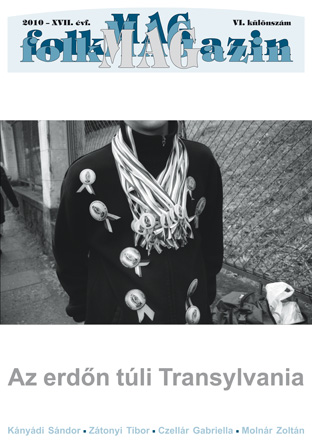Articles by Initial Letters
Az erdőn túli Transylvania
- Issue: 2010/x
- Starting page: 3
- Author: Bába Imre , Czellár Gabriella , Kányádi Sándor , Molnár Zoltán , Zátonyi Tibor
- =>
„Az erdőn túli Transylvania” [Transylvania beyond the forest] contains photographs by Zátonyi Tibor, Czellár Gabriella and Molnár Zoltán. On the first page, a piece written about Transylvania by cartographer Bába Imre sets the tone with commentary about effects of history, the geographical and political isolation on the Hungarians in Transylvania and ecological conditions in the region.
A poem from 1965 entitled "Nyergestető” by Transylvanian poet Kányádi Sándor runs the length of the publication with a line on each page. Molnár Zoltán developed the concept for the publication.
All ten black and white photographs by Zátonyi Tibor were taken during the Csíksomlyó/ Șumuleu Ciuc pilgrimage in 2006. It is a pilgrimage of Hungarians who travel at Pentecost to the Roman Catholic church of Csíksomlyó the town of Csíkszereda/Miercurea Ciuc in Transylvania, Romania. The most important object in the church at Csíksomlyó is a 227 cm high statue of the Virgin Mary - the co-called "Babba Mária dressed in the sun". Over the centuries miracles were reported to have happened there. Several times the statue was said to have shone with light that filled the church. In 1661 the statue miraculously remained undamaged when the church was ravaged and set on fire by Tartars and Turks. Along with its religious importance, the pilgrimage has also become a community event demonstrating spiritual unity of Hungarian people living in and outside the historical region of Transylvania.
Czellár Gabiella’s 10 color photographs are from 2007. They portray the Gyimes and Moldavian Csángó Hungarians (though one photo is of a shepherd and his dog from nearby Csíkkarcfalva/ Cârța, Harghita County, RO). The Csángós (in Romanian: Ceangăi) are a Hungarian ethnic group of Roman Catholic faith living mostly in the Romanian region of Moldavia, especially in Bacău County. Their traditional language, an old Hungarian dialect, is currently used by only a minority of the Csángó population group. Some Csángós also live in Transylvania around the Ghimeș-Palanca Pass and in the so-called Seven Csángó Villages .
Molnár Zoltán’s 10 black and white photographs were taken between 2000 and 2009, many of them in Kiskapus/ Copșa Mică - a town in Sibiu County, Transylvania, Romania. At the 2011 census, 78.8% of inhabitants of the town were Romanian, 11.9% Roma and 8.7% Hungarian. The town is best known for its status (in the 1990s) as one of the most polluted in Europe. This was due to emissions of two factories in the area:
• One, open from 1935 to 1993, produced carbon black for dyes; its emissions permeated the area for nearly sixty years, leaving soot on homes, trees, animals, and everything else in the area. The stains from these decades of deposits are still visible.
• The other source of the pollution, less visible but with even more serious effects to the health of the town's residents, was Sometra, a smelter whose emissions have contributed to significantly higher incidence of lung disease and impotence, along with a and a life expectancy nine years below Romania's average.





